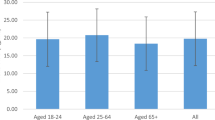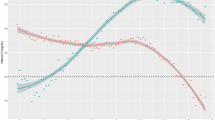Abstract
Background/Objectives:
Middle Eastern female immigrants are at an increased risk of vitamin D deficiency and their response to prescribed vitamin D dosages may not be adequate and affected by other factors. The objectives were to determine vitamin D deficiency and its determinants in Middle Eastern women living in Auckland, New Zealand (Part-I), and to determine serum 25-hydroxyvitamin D (serum-25(OH)D) response to two prescribed vitamin D dosages (Part-II) in this population.
Participants/Methods:
Women aged ⩾20 (n=43) participated in a cross-sectional pilot study during winter (Part-I). In Part-II, women aged 20–50 years (n=62) participated in a randomised, double-blind placebo-controlled trial consuming monthly either 50 000, 100 000 IU vitamin D3 or placebo for 6 months (winter to summer).
Results:
All women in Part-I and 60% women in Part-II had serum-25(OH)D<50 nmol/l. Serum-25(OH)D was higher in prescribed vitamin D users than nonusers (P=0.001) and in Iranians than Arab women (P=0.001; Part-I). Mean (s.d.) serum-25(OH)D increased in all groups (time effect, P<0.001) and differed between groups (time × dosage interaction, P<0.001; 50 000 IU: from 44.0±16.0 to 70.0±15.0 nmol/l; 100 000 IU: 48.0±11.0 to 82.0±17.0 nmol/l; placebo: 45.0±18.0 to 54.0±18.0 nmol/l). Only 32% and 67% achieved serum-25(OH)D⩾75 nmol/l with 50 000 and 100 000 IU/month, respectively. Predictors of 6-month change in serum-25(OH)D were dose (B-coefficient±s.e.; 14.1±2.4, P<0.001), baseline serum-25(OH)D (−0.6±0.1, P<0.001) and body fat percentage (−0.7±0.3, P=0.01).
Conclusions:
Vitamin D deficiency/insufficiency is highly prevalent in this population. Monthly 100 000 IU vitamin D for 6 months is more effective than 50 000 IU in achieving serum-25(OH)D ⩾75 nmol/l; however, a third of women still did not achieve these levels.
This is a preview of subscription content, access via your institution
Access options
Subscribe to this journal
Receive 12 print issues and online access
$259.00 per year
only $21.58 per issue
Buy this article
- Purchase on Springer Link
- Instant access to full article PDF
Prices may be subject to local taxes which are calculated during checkout


Similar content being viewed by others
References
Holick MF . Vitamin D: A D-lightful health perspective. Nutr Rev 2008; 66: S182–S194.
Kulie T, Groff A, Redmer J, Hounshell J, Schrager S . Vitamin D: an evidence-based review. J Am Board Fam Med 2009; 22: 698–706.
Lips P . Worldwide status of vitamin D nutrition. J Steroid Biochem Mol Biol 2010; 121: 297–300.
Arabi A, Baddoura R, El-Rassi R, El-Hajj Fuleihan G . PTH level but not 25 (OH) vitamin D level predicts bone loss rates in the elderly. Osteoporos Int 2012; 23: 971–980.
Muhairi SJ, Mehairi AE, Khouri AA, Naqbi MM, Maskari FA, Kaabi J et al. Vitamin D deficiency among healthy adolescents in Al Ain, United Arab Emirates. BMC Public Health 2013; 13: 33.
Zabihiyeganeh M, Jahed A, Nojomi M . Treatment of hypovitaminosis D with pharmacologic doses of cholecalciferol, oral vs intramuscular; an open labeled RCT. Clin Endocrinol (Oxf) 2013; 78: 210–216.
Holvik K, Meyer HE, Haug E, Brunvand L . Prevalence and predictors of vitamin D deficiency in five immigrant groups living in Oslo: The Oslo immigrant health study, Norway. Eur J Clin Nutr 2005; 59: 57–63.
Van Der Meer IM, Karamali NS, Boeke AJP, Lips P, Middelkoop BJC, Verhoeven I et al. High prevalence of vitamin D deficiency in pregnant non-Western women in the Hague, Netherlands. Am J Clin Nutr 2006; 84: 350–353.
Hobbs R, Habib Z, Alromaihi D, Idi L, Parikh N, Blocki F et al. Severe Vitamin D Deficiency in Arab-American women living in Dearborn, Michigan. Endocr Pract 2009; 15: 35–40.
Perumal L . Health needs assessment of Middle Eastern, Latin American and African people living in the Auckland region. Auckland District Health Board: Auckland, New Zealand, 2010.
Holick MF . Sunlight "D"ilemma: risk of skin cancer or bone disease and muscle weakness. Lancet 2001; 357: 4–6.
Ministry of Health and Cancer Society of New Zealand. Consensus Statement on Vitamin D and Sun Exposure in New Zealand. In: Health Mo. eds, Ministry of Health: Wellington, New Zealand, 2012.
Ministry of Health, NHMRC Nutrient Reference Values for Australia and New Zealand Including Recommended Dietary Intakes. Ministry of Health and Nutritional Health and Medical Research Council, 2006.
Ross AC, Manson JE, Abrams SA, Aloia JF, Brannon PM, Clinton SK et al. The 2011 report on dietary reference intakes for calcium and vitamin D from the Institute of Medicine: what clinicians need to know. J Clin Endocrinol Metab 2011; 96: 53–58.
Rizzoli R, Boonen S, Brandi M-L, Bruyère O, Cooper C, Kanis JA et al. Vitamin D supplementation in elderly or postmenopausal women: a 2013 update of the 2008 recommendations from the European Society for Clinical and Economic Aspects of Osteoporosis and Osteoarthritis (ESCEO). Curr Med Res Opin 2013; 29: 305–313.
Bischoff-Ferrari HA, Willett WC, Orav EJ, Lips P, Meunier PJ, Lyons RA et al. A pooled analysis of vitamin D dose requirements for fracture prevention. N Engl J Med 2012; 367: 40–49.
Al-Daghri NM, Alkharfy KM, Al-Othman A, El-Kholie E, Moharram O, Alokail MS et al. Vitamin D supplementation as an adjuvant therapy for patients with T2DM: an 18-month prospective interventional study. Cardiovasc Diabetol 2012; 11: 85.
Talwar SA, Aloia JF, Pollack S, Yeh JK . Dose response to vitamin D supplementation among postmenopausal African American women. Am J Clin Nutr 2007; 86: 1657–1662.
Gallagher JC, Peacock M, Yalamanchili V, Smith LM . Effects of vitamin D supplementation in older African American women. J Clin Endocrinol Metab 2013; 98: 1137–1146.
Aloia JF, Patel M, DiMaano R, Li-Ng M, Talwar SA, Mikhail M et al. Vitamin D intake to attain a desired serum 25-hydroxyvitamin D concentration. Am J Clin Nutr 2008; 87: 1952–1958.
Logan VF, Gray AR, Peddie MC, Harper MJ, Houghton LA . Long-term vitamin D3 supplementation is more effective than vitamin D2 in maintaining serum 25-hydroxyvitamin D status over the winter months. Br J Nutr 2013; 109: 1082–1088.
Biancuzzo RM, Clarke N, Reitz RE, Travison TG, Holick MF . Serum concentrations of 1,25-Dihydroxyvitamin D2 and 1,25-Dihydroxyvitamin D3 in response to vitamin D2 and vitamin D3 supplementation. J Clin Endocrinol Metab 2013; 98: 973–979.
Nelson ML, Blum JM, Hollis BW, Rosen C, Sullivan SS . Supplements of 20 μg/d cholecalciferol optimized serum 25-Hydroxyvitamin D concentrations in 80% of premenopausal women in winter. J Nutr 2009; 139: 540–546.
Zittermann A, Prokop S, Gummert F, Borgermann J, Safety J . Issues of Vitamin D Supplementation. Anticancer Agents Med Chem 2013; 13: 4–10.
von Hurst PR, Stonehouse W, Coad J . Vitamin D status and attitudes towards sun exposure in South Asian women living in Auckland, New Zealand. Public Health Nutr 2010; 13: 531–536.
Fitzpatrick TB . The validity and practicality of sun-reactive skin types i through vi. Arch Dermatol 1988; 124: 869–871.
SPARC, McLean G, Tobias M . The New Zealand Physical Activity Questionnaires: Report on the Validation and Use of the NZPAQ-LF and NZPAQ-SF Self-report Physical Activity Survey Instruments 2004, http://www.sparc.org.nz/research-policy/research/nzspas-97-01/nzpaq.
Ministry of Health Vitamin D Status of New Zealand Adults. Findings from the 2008/09 New Zealand Adult Nutrition Survey. Ministry of Health, 2012.
Barger-Lux MJ, Heaney RP . Effects of above average summer sun exposure on serum 25-Hydroxyvitamin D and calcium absorption. J Clin Endocrinol Metab 2002; 87: 4952–4956.
Giovannucci E, Liu Y, Hollis BW, Rimm EB . 25-Hydroxyvitamin D and risk of myocardial infarction in men: a prospective study. Arch Intern Med 2008; 168: 1174–1180.
Carroll MF, Schade DS . A practical approach to hypercalcemia. Am Fam Physician 2003; 67: 1959–1966.
Maghbooli Z, Hossein-Nezhad A, Shafaei AR, Karimi F, Madani FS, Larijani B . Vitamin D status in mothers and their newborns in Iran. BMC Pregnancy Childbirth 2007; 7: 1.
Rassouli A, Milanian I, Moslemi-Zadeh M . Determination of serum 25-hydroxyvitamin D3 levels in early postmenopausal Iranian women: relationship with bone mineral density. Bone 2001; 29: 428–430.
Hosseinpanah F, Pour SH, Heibatollahi M, Moghbel N, Asefzade S, Azizi F . The effects of air pollution on vitamin D status in healthy women: a cross sectional study. BMC Public Health 2010; 10: 519.
Saadi HF, Dawodu A, Afandi BO, Zayed R, Benedict S, Nagelkerke N . Efficacy of daily and monthly high-dose calciferol in vitamin D–deficient nulliparous and lactating women. Am J Clin Nutr 2007; 85: 1565–1571.
Field AP . Discovering statistics using SPSS. SAGE: Los Angeles, 2009.
Judkins A, Eagleton C . Vitamin D deficiency in pregnant New Zealand women. N Z Med J 2006; 119: 1241.
Rockell JEP, Skeaff CM, Venn BJ, Williams SM, Green TJ . Vitamin D insufficiency in New Zealanders during the winter is associated with higher parathyroid hormone concentrations: implications for bone health? N Z Med J 2008; 121: 75–84.
Von Hurst PR, Stonehouse W, Coad J . Vitamin D supplementation reduces insulin resistance in South Asian women living in New Zealand who are insulin resistant and vitamin D deficient-a randomised, placebo-controlled trial. Br J Nutr 2010; 103: 549–555.
Vieth R, Chan P-CR, MacFarlane GD . Efficacy and safety of vitamin D3 intake exceeding the lowest observed adverse effect level. Am J Clin Nutr 2001; 73: 288–294.
Blum M, Dolnikowski G, Syoum E, Harris SS, Booth SL, Peterson J et al. Vitamin D3 in fat tissue. Endocr Pract 2008; 33: 90–94.
Holick MF . Vitamin D Deficiency. N Engl J Med 2007; 357: 266–281.
Brouwer DA, van Beek J, Ferwerda H, Brugman AM, van der Klis FR, van der Heiden HJ et al. Rat adipose tissue rapidly accumulates and slowly releases an orally-administered high vitamin D dose. Br J Nutr 1998; 79: 527–532.
Wortsman J, Matsuoka LY, Chen TC, Lu Z, Holick MF . Decreased bioavailability of vitamin D in obesity. Am J Clin Nutr 2000; 72: 690–693.
Piccolo BD, Dolnikowski G, Seyoum E, Thomas AP, Gertz ER, Souza EC et al. Association between subcutaneous white adipose tissue and serum 25-hydroxyvitamin D in overweight and obese adults. Nutrients 2013; 5: 3352–3366.
Heaney RP, Davies KM, Chen TC, Holick MF, Barger-Lux MJ . Human serum 25-hydroxycholecalciferol response to extended oral dosing with cholecalciferol. Am J Clin Nutr 2003; 77: 204–210.
Acknowledgements
We wish to thank research project manager, Owen Mugridge, and laboratory manager, PC Tong, for their ongoing support and help The study was registered under the Trial registration no: ACTRN12613000383763.
Author information
Authors and Affiliations
Corresponding author
Ethics declarations
Competing interests
The authors declare no conflict of interest.
Rights and permissions
About this article
Cite this article
Mazahery, H., Stonehouse, W. & von Hurst, P. The effect of monthly 50 000 IU or 100 000 IU vitamin D supplements on vitamin D status in premenopausal Middle Eastern women living in Auckland. Eur J Clin Nutr 69, 367–372 (2015). https://doi.org/10.1038/ejcn.2014.264
Received:
Revised:
Accepted:
Published:
Issue Date:
DOI: https://doi.org/10.1038/ejcn.2014.264
This article is cited by
-
Relationship between vitamin D, iron, and hepcidin in premenopausal females, potentially confounded by ethnicity
European Journal of Nutrition (2023)
-
A randomized double-blinded placebo controlled trial of ergocalciferol 40,000 versus 100,000 IU per week for vitamin D inadequacy in institutionalized postmenopausal women
Aging Clinical and Experimental Research (2020)
-
Vitamin-D2 treatment-associated decrease in 25(OH)D3 level is a reciprocal phenomenon: a randomized controlled trial
BMC Endocrine Disorders (2019)
-
A Randomised-Controlled Trial of Vitamin D and Omega-3 Long Chain Polyunsaturated Fatty Acids in the Treatment of Core Symptoms of Autism Spectrum Disorder in Children
Journal of Autism and Developmental Disorders (2019)
-
Differential effects of vitamin D2 and D3 supplements on 25-hydroxyvitamin D level are dose, sex, and time dependent: a randomized controlled trial
BMC Endocrine Disorders (2017)



